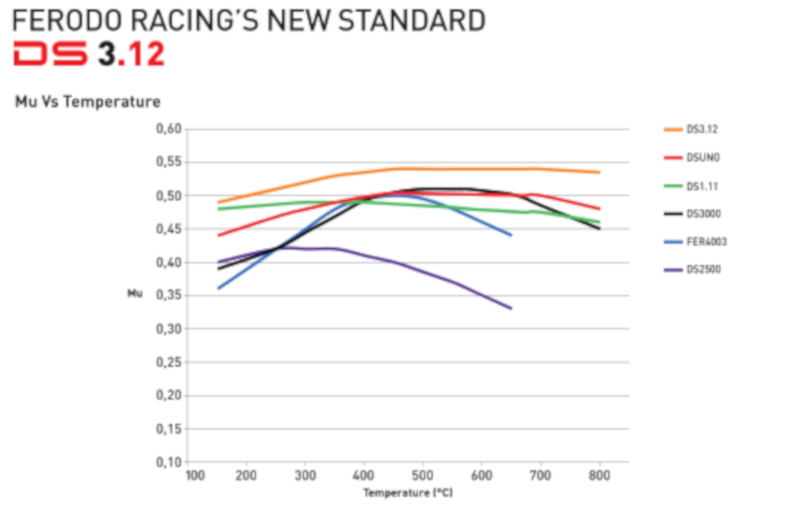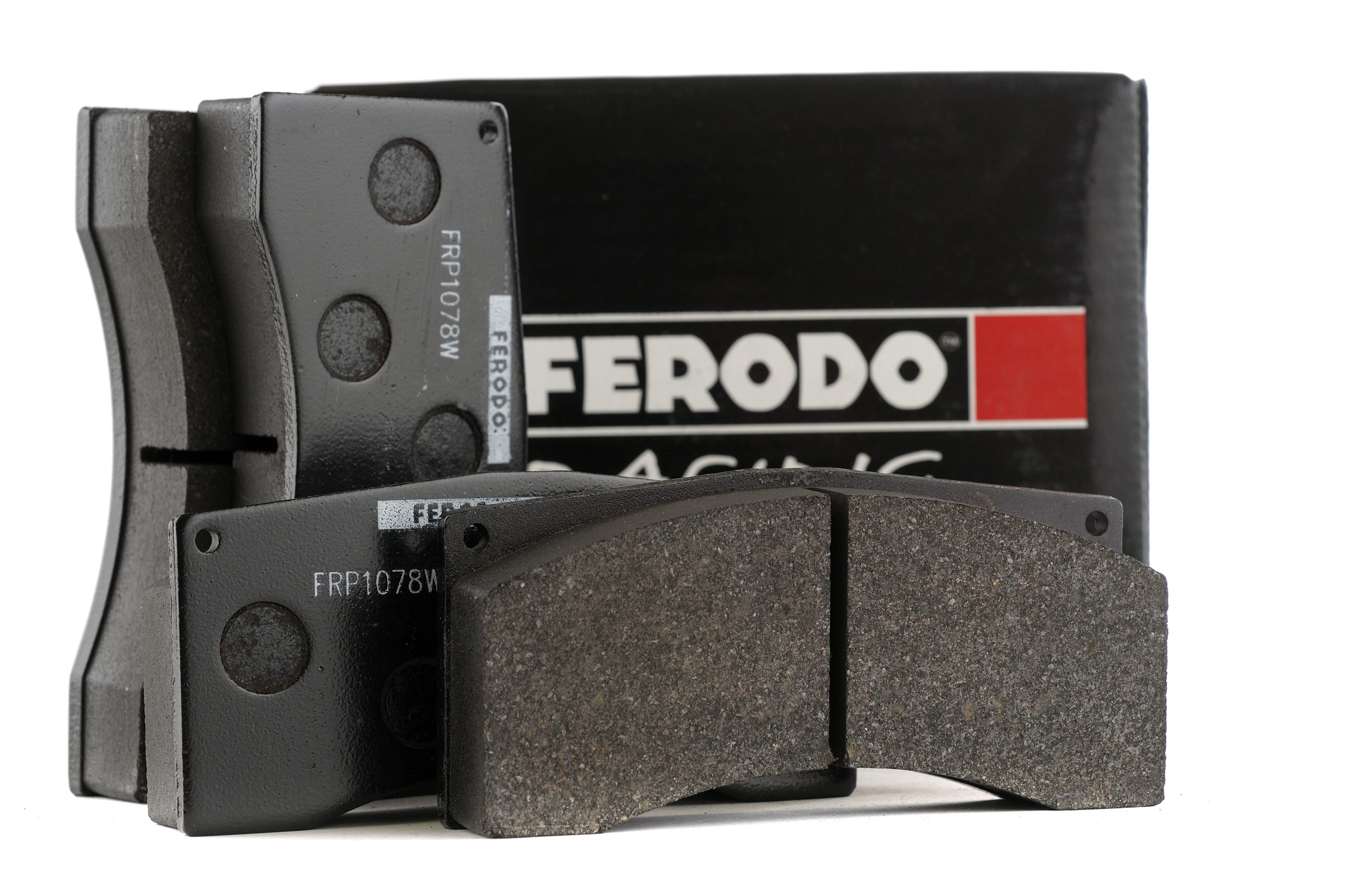Ferodo Racing DS3.12 Brake Pads: A New Benchmark for Control
02.20.2020
by Jeff Ritter@ Essex

Coefficient of Friction and Maximum Operating Temperature
Any time you rub two objects against each other friction is generated. In this case we’re rubbing a semi-metallic brake pad against a spinning iron disc. Mu (μ) refers to the coefficient of friction of a pad compound. In simple terms, that means the amount of friction that exists between the brake pads and disc. The mu value for most brake pads falls within the 0.3 to 0.6 range. The closer a pad’s mu value is to zero, the less friction exists between the pad and disc. Pads with a low coefficient of friction are often described as feeling wooden, not having much bite or grab, or the driver feels like they must press the brake pedal with a lot of force to get the car to slow. Conversely, a pad with a mu value closer to one feels like it doesn’t require as much leg effort for the pad to ‘bite’ into the disc and slow the car. If the mu is too high however, the brakes may feel like a light switch. They’re either on or off, and difficult to control with varied pedal pressure (modulation). Breathing on them lightly or trail braking could prove difficult. The best pad compounds hit a sweet spot in terms of balancing pedal pressure and controllability.
What makes mu both interesting and complicated is that it changes constantly with temperature. The Holy Grail of brake pads would be a compound that has a perfectly flat mu curve across the entire temperature range from zero degrees to the highest temperature the pad would ever reach (for the typical HPDE driver or club racer that is approximately 1400°F). Such a pad would exhibit a linear response through the brake pedal, regardless of where and how it was being driven. From the driver’s perspective, that would mean every time they pressed the brake pedal with the same amount of force, the car would feel as if it slowed at the same rate. That consistent feedback loop would allow the driver to dial in their brain and leg to precisely control the car’s response. Each time they approached a turn, they would feel confident about how the car was going to react when they stepped on the brake pedal. When trying to shave a tenth of a second at every turn, one can imagine how valuable that would be!
Unfortunately, most pad materials have a narrow temperature window in which they generate a given amount of mu. Depending on the pad’s constituent materials, that temperature window may be what you experience when driving to the grocery store (street pads optimized for low temps), or it may be the temperatures you experience on Lap 6 at Watkins Glen (race pads optimized for high temps). To this day, no pad material exists that generates the same mu across its entire operating temperature range.
Pads also have a maximum operating temperature, which is the highest temperature at which the material can still generate friction. At some elevated temperature, any given pad is going to start burning more quickly, melting, vaporizing, etc. At that point it can no longer generate as much friction on the disc face, and its mu tapers towards zero. The brake pedal may still feel firm, but the car isn’t slowing at your anticipated rate because very little friction is being generated between the pad and disc. That is what is referred to as pad fade. In these situations, the pad can also stick to the disc face in globs, smear, and create high spots that cause judder and vibration. We frequently see this when people drive street pads on the racetrack, because street pads have a lower maximum operating temperature than race pads and are not designed to operate at track temps. What is particularly scary about some street pads is that once they approach their maximum operating temperature their mu falls off a cliff and rapidly approaches zero. In real world terms, that means the driver doesn’t receive any warning. On one stop the car slows as expected, and on the next you need to press the pedal much harder to get a similar reaction from the brakes.
With a typical race pad, mu is low when the pad material is cold. If you push hard on the brake pedal, it doesn’t feel as if the pads are gripping the brake disc very hard. Many people refer to this pad attribute as its ‘cold bite’. As the disc and pad temperatures rise however, mu increases, and the driver doesn’t have to press very hard for them to grab the brake disc. Track pads also have more gradually tapering mu when temperatures get extremely high, which means they give more warning as they approach their max operating temperature.
Looking at a Brake Dyno Plot
The first thing to consider when looking at a brake dyno graph is that all brake dynamometers are different. One can view this situation exactly like engine dynos. The mu numbers one manufacturer claims or generates on their dyno aren’t comparable to the numbers generated by another manufacturer. The machines are different, and the test parameters are different: number of brake events, different stop durations, different amount of time between stops, different caliper pressures, etc. We constantly see people on message forums comparing mu values across pad manufacturers, but doing so is futile. A Brand X pad that Brand X claims has a mu of 0.5 at 1000°F is not the same as a Ferodo pad that Ferodo claims has a mu of 0.5 at 1000°F. No comparative conclusions can be drawn from looking at mu graphs from different manufacturers. The only value of a manufacturer’s brake dyno graph is to compare within that manufacturer’s line of brake pads (assuming the same procedures and machine were used to produce the results for all data on that graph). For example, comparing the Ferodo DS2500 to the DS3.12 on a Ferodo dyno plot is a valid comparison. The specific numbers are essentially irrelevant since you can’t compare them to other brands (unless you have your own brake dyno), but the shape of the curve and relative differences between the Ferodo pad compounds does provide valuable information. Again, ignore the actual numbers and focus on the relative differences and the shape of the curves.
The above is one of the reasons why Essex built our own brake dyno, so we can conduct comparative testing both for ourselves and for our race team customers. We can execute apples-to-apples pad tests, and we know what we have before its ever run on a car. We also don’t have to blindly accept a manufacturer’s data. We find out on our own what we have, and how it compares to other available products that we’ve tested on our dyno, via our own procedures.
On to the dyno graph! The dyno results below was provided by Ferodo, but we’ve seen similar relative results on our own Essex brake dyno. The value of this graph is that it shows the relative mu of several Ferodo pad compounds across a broad temperature range. If we look at the new DS3.12 compound’s plot, we see that it has higher mu across the board from stone cold to searing hot vs. any prior Ferodo compound. That means the DS3.12 is always going to feel as if it requires less pedal effort vs. the DS1.11, regardless of whether you’re on your morning commute or driving a session at Road America. With the DS3.12 you won’t have to press the pedal as hard to slow the car.
What’s shocking about the DS3.12 is that it exhibits almost no variation in mu across an amazingly wide temperature range. Out of all the pad compounds we’ve ever tested, from all manufacturers, the DS3.12 shows the flattest torque curve across the broadest temperature range. On track, most of our customers will be running their pads in the 700-1400°F range (400-750°C). Across that range, the mu curve for DS3.12 is table-top flat. That means that on every turn, on every track you drive, on every lap, your brake pedal is going to feel almost exactly the same, providing tremendous consistency and repeatability.
What we also noted on our dyno about the DS3.12 that cannot be seen on the dyno graph, is the compound’s response to varying pressures. When we test a pad, we vary the clamp load on the pad and disc. The DS3.12 shows an amazingly linear response to varying pressures, which is not the case for many other pad compounds we’ve tested over the years.The real-world benefit of this linear pressure-response is that it allows the driver to precisely modulate brake torque through the pedal.
If you look at the DS1.11 plot, you can see that it responds a bit differently vs. the DS3.12. As temperature rises, mu tapers off gradually. What that feels like as you go deeper into a brake event, is that you must press a little harder on the pedal to get the desired response from the pad. Some people like having to press harder, because it feels natural to them. Others don’t and prefer a more linear pressure throughout the entire stop, which is what the DS3.12 offers. There is no good or bad in this case, and the feel you prefer is completely a matter of personal preference.

Real World Results
Theoretical results are great, but even better are real world results that confirm what we’ve seen in testing.That’s precisely what we’ve seen since the DS3.12’s introduction last year.The DS3.12 has already accumulated numerous race wins at various levels of pro and amateur racing, both in the United States and abroad.Our club racing and HPDE customers who have tried them have been smitten, and they keep coming back for more (you can see owner feedback on the Essex Blog). They’ve told us that once they calibrate their brain and leg to the DS3.12’s higher mu level, which requires less leg pressure, they are the ultimate pad for consistent threshold braking.The DS3.12’s incredibly flat torque curve and linear response to varying pressures both contribute to a tremendous amount of control.
I’ve had the DS3.12 installed in my personal track car for about a year now (built C6 Corvette), and they are phenomenal.During my nearly 20 years in the brake business, I’ve had the opportunity to try a huge range of pad compounds from many different manufacturers, and the DS3.12 are as good as anything I’ve ever used.While thrashing my car at VIR I never came close to fading them, and they are wearing incredibly well. They aren’t tearing up my discs, even when I drive them around town cold. They have enough cold bite for Sunday morning drives, and most shockingly, they’ve never made a single peep of noise on my car.That almost never happens with race pads!In summary, they are the best-performing, most versatile racing brake pads I’ve ever used.The DS3.12 is a truly world-class compound that achieves some things we’ve never seen before among modern racing brake pads, and we think you’ll be as excited about them as we are!
To find DS3.12 for your car, Here is the link to Apex Performance’s brake reference charts for Porsche. We can also source DS3.12 for any other vehicle that Essex offers so feel free to contact us with special requests!

